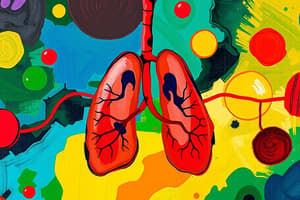Podcast
Questions and Answers
What is the primary role of NADH and FADH₂ in cellular respiration?
What is the primary role of NADH and FADH₂ in cellular respiration?
- To act as high-energy electron carriers that fuel the electron transport chain (correct)
- To directly produce ATP through substrate-level phosphorylation
- To transport glucose across the cell membrane into the mitochondria
- To break down pyruvate into carbon dioxide molecules
During intense exercise when oxygen is depleted in muscle cells, which process allows for ATP production in those conditions?
During intense exercise when oxygen is depleted in muscle cells, which process allows for ATP production in those conditions?
- Electron Transport Chain
- Alcoholic Fermentation
- Krebs Cycle
- Lactic Acid Fermentation (correct)
Which of the following accurately describes the location and necessity of oxygen for the Krebs cycle?
Which of the following accurately describes the location and necessity of oxygen for the Krebs cycle?
- Occurs in the inner mitochondrial membrane and does not require oxygen.
- Occurs in the cytoplasm and is an anaerobic process.
- Occurs in the mitochondrial matrix and requires oxygen. (correct)
- Occurs in the cytoplasm and requires oxygen.
Which of the following products are generated during glycolysis?
Which of the following products are generated during glycolysis?
What is the primary purpose of fermentation in anaerobic conditions?
What is the primary purpose of fermentation in anaerobic conditions?
What is the precise role of the electron transport chain in cellular respiration?
What is the precise role of the electron transport chain in cellular respiration?
Which of the following processes is not considered a stage of aerobic cellular respiration?
Which of the following processes is not considered a stage of aerobic cellular respiration?
In the overall equation for cellular respiration, what role does molecular oxygen (O₂) serve?
In the overall equation for cellular respiration, what role does molecular oxygen (O₂) serve?
Flashcards
What is cellular respiration?
What is cellular respiration?
The process that releases energy (ATP) from sugars and other carbon-based molecules.
What is glycolysis?
What is glycolysis?
A series of reactions that breaks down glucose into pyruvate, releasing a small amount of ATP. It occurs in the cytoplasm and does not require oxygen.
What is the Krebs cycle?
What is the Krebs cycle?
A cycle that occurs in the mitochondrial matrix, oxidizing pyruvate to CO2, producing a small amount of ATP, and generating electron carriers for the next stage.
What is the Electron Transport Chain (ETC)?
What is the Electron Transport Chain (ETC)?
Signup and view all the flashcards
What is fermentation?
What is fermentation?
Signup and view all the flashcards
What is ATP?
What is ATP?
Signup and view all the flashcards
What are NADH and FADH2?
What are NADH and FADH2?
Signup and view all the flashcards
What is the mitochondria?
What is the mitochondria?
Signup and view all the flashcards
Study Notes
Cellular Respiration
- A process releasing energy (ATP) from sugars and other carbon-based molecules
- Equation: C6H12O6 + 6O2 → 6CO2 + 6H2O + ATP
Before Cellular Respiration
- Food (e.g., carbohydrates) breaks down into glucose
- Glucose converts into pyruvate through glycolysis
- "Glyco" means sugar, "lysis" means to break apart
Stages of Cellular Respiration
1. Glycolysis
- Location: cytoplasm
- Reactants: glucose and NAD+
- Products: 2 pyruvate, 2 ATP, and NADH
- Does not require oxygen (anaerobic)
2. Krebs Cycle (Citric Acid Cycle)
- Location: mitochondrial matrix
- Reactants: pyruvate, NAD+, and FAD
- Products: CO2, NADH, FADH2, and a small amount of ATP
- Prepares energy carriers (NADH and FADH2) for the next stage.
- Requires oxygen (aerobic)
3. Electron Transport Chain (ETC)
- Location: inner mitochondrial membrane
- Reactants: NADH, FADH2, and O2
- Products: H2O, NAD+, FAD, and the majority of ATP (34-36 ATP)
- Requires oxygen (aerobic)
Fermentation (When oxygen is unavailable)
1. Lactic Acid Fermentation
- Location: cytoplasm
- Reactants: pyruvate and NADH
- Products: lactic acid and NAD+
- Provides 2 ATP via glycolysis
- Occurs in muscle cells during intense exercise
2. Alcoholic Fermentation
- Location: cytoplasm
- Reactants: pyruvate and NADH
- Products: ethanol, CO2, and NAD+
- Provides 2 ATP via glycolysis
- Used by yeast in brewing and baking
Aerobic vs. Anaerobic Respiration
- Aerobic Respiration: Requires oxygen, takes place in cytoplasm and mitochondria, produces 36-38 ATP, Reactants: Glucose and O2. Products: CO2, H2O, NAD+, FAD.
- Anaerobic Respiration: Does not require oxygen, takes place in cytoplasm, produces 2 ATP, Reactants: Glucose and NADH, Products: Lactic acid (or ethanol + CO2), NAD+.
Key Terms
- ATP (Adenosine Triphosphate): The main energy carrier in cells
- NADH & FADH2: High-energy electron carriers used in the ETC to produce ATP
- Mitochondria: The organelle where aerobic respiration occurs; the powerhouse of the cell
- Glycolysis: The first step of cellular respiration, breaking glucose into pyruvate
- Fermentation: An anaerobic process that regenerates NAD+ to keep glycolysis running
Studying That Suits You
Use AI to generate personalized quizzes and flashcards to suit your learning preferences.




